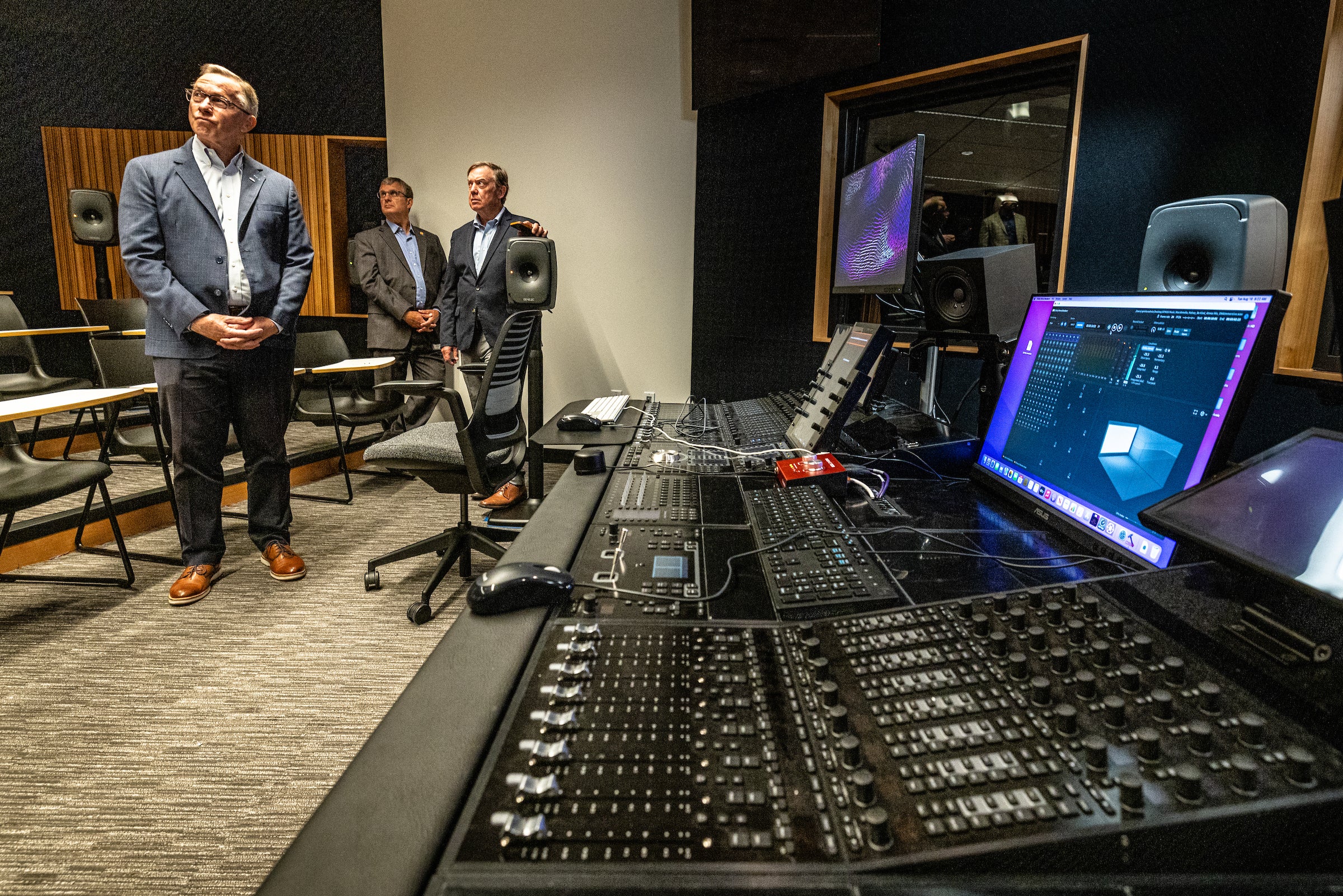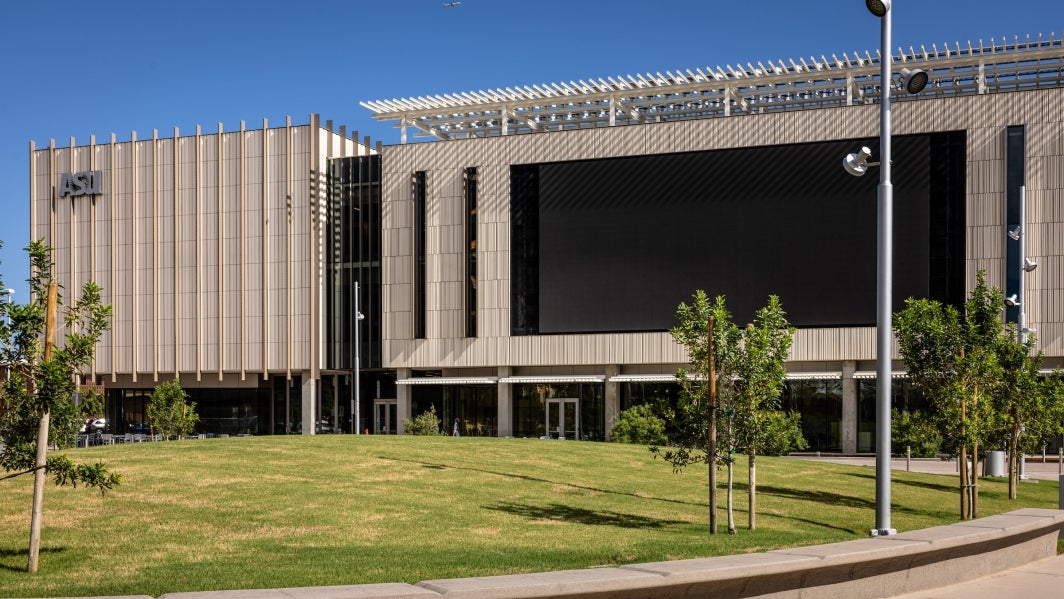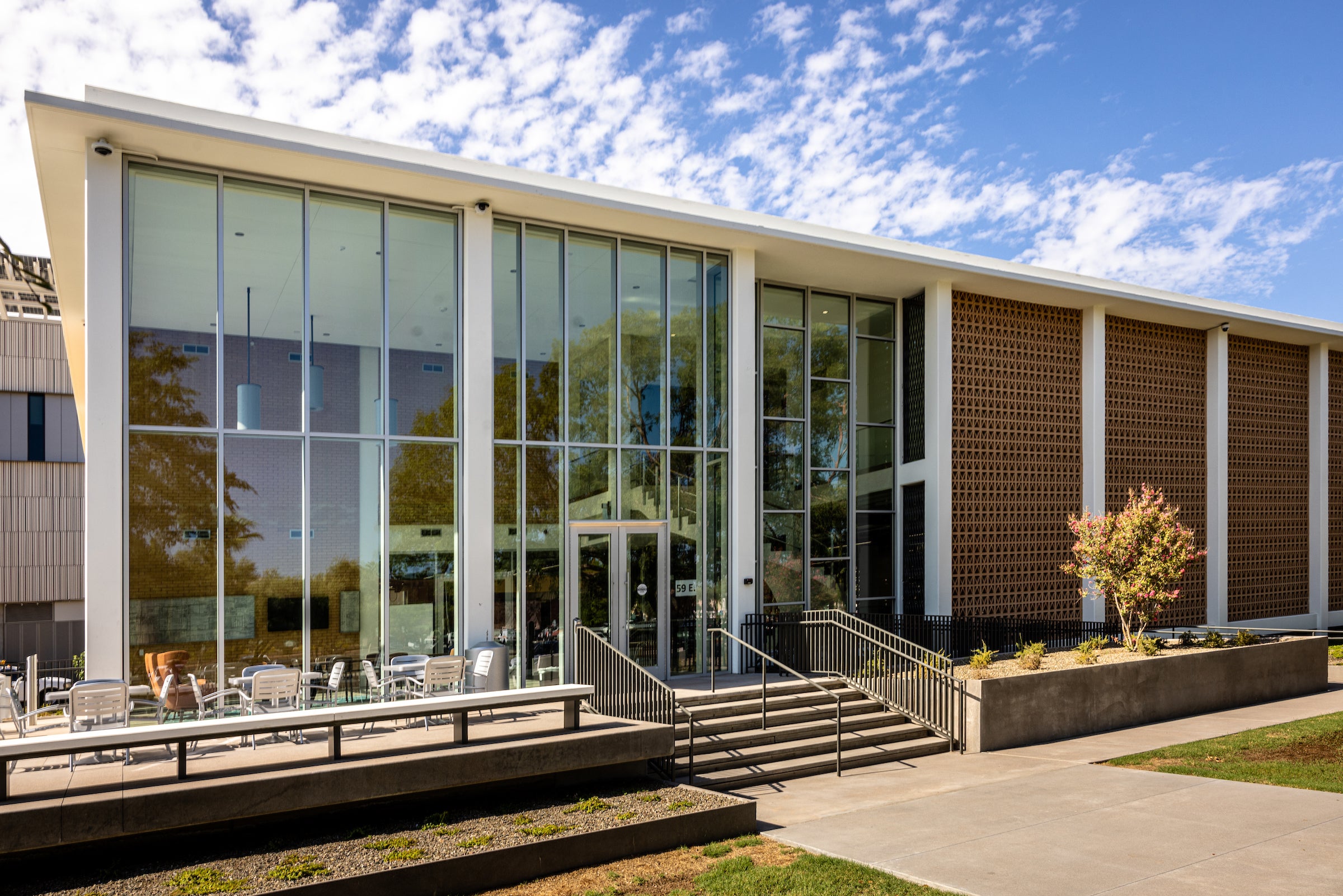Editor’s note: This story is featured in the 2022 year in review.
The new Media and Immersive eXperience Center in downtown Mesa — which opened its doors to students this month as the fall semester began — will put Arizona State University in the top tier of academic filmmaking and media production facilities.
The cutting-edge building, called the MIX Center, is capable of producing anything from blockbuster superhero movies to VR videogames — and teaching students the skills they need to succeed in a digital economy.
The MIX Center is part of ASU at Mesa City Center, which also includes an outdoor plaza space with a 100-foot movie screen and The Studios. The Studios at Mesa City Center is a repurposed mid-century building that houses programming and support services for local community entrepreneurs, facilitated by the J. Orrin Edson Entrepreneurship and Innovation Institute.
The MIX Center hosts hundreds of students who will be making films, designing virtual worlds and creating immersive media experiences. It houses The Sidney Poitier New American Film School's production and post-production programs, plus classes in digital media technology, worldbuilding, experience design and gaming from The Design School and the School of Arts, Media and Engineering (both, like the Poitier Film School, part of the Herberger Institute for Design and the Arts), as well as from the Ira A. Fulton Schools of Engineering and the College of Global Futures.
ASU President Michael Crow said of the building: “There’s nothing that can be imagined that you can’t do here.
“What it means for students is that they will have the foundation to get deeply involved in new industries, in manufacturing, in entertainment, in digital expression. They’ll have every tool imaginable for the digital economy.”
The project is a partnership between ASU and the city of Mesa. The city invested $63.5 million toward the project and managed the design and construction of the building while ASU contributed $33.5 million, which included interior work and high-end equipment. ASU also will pay all operations and maintenance costs for the MIX Center; costs will be shared with the city of Mesa for The Studios.
Mesa Mayor John Giles said that the complex is important to educational attainment in the city.
“Mesa needs to be a college town, and that’s happening,” he said. “Downtown Mesa is a very special place. It has a lot of character and a lot of resources. What we need is a few more people, and with this facility now open, it will be fun to see more activity.”
The Studios and many of the spaces in the MIX Center are fully open to the community, including the fabrication studio.
Crow said that ASU’s presence will help downtown Mesa evolve.
“The downtowns that are most successful are those that have a broad orientation but also have some type of intense creativity going on, and this is a huge catalyst for that,” he said.
Clockwise from left: city of Mesa Mayor John Giles, city of Mesa Manager Chris Brady and ASU President Michael Crow check out a sound studio during a tour of the MIX Center in downtown Mesa on Aug. 16. Photo by Charlie Leight/ASU News
Top of the line
Here are some of the cool things in the MIX Center:
High-tech sound stages: The building has three sound stages with a total of more than 8,000 square feet of Hollywood-level space. Two smaller stages are designed for teaching, and the largest one is built up to full, professional cinematic quality.
“If you came off a Marvel lot in Atlanta and you came here, you wouldn’t find anything missing – the rigging, the power distribution, the acoustic insulation — everything is up to top-of-the-line standards,” said Jake Pinholster, founding director of the MIX Center and executive dean in the Herberger Institute.
“It’s one of the best — if not the best — academic sound stages in the country.”
Two screening rooms: The two rooms, one with 261 seats and one with 76 seats, off the lobby have Dolby Atmos sound and will be used for lectures and post-production work on films as well as public screenings.
“Not only is it the best sound of any movie theater you’ve ever been in, it’s the level of sound where if you finish a movie in here, you get the Dolby Atmos stamp on it at the end,” Pinholster said.
Because there is no movie theater directly in downtown Mesa, the MIX Center will offer public screenings of family, classic and indie films, likely starting late in 2022.
Enhanced immersion studio: This three-story “black box” showcase space is for anything that is not entirely media-based, such as live performances and interactive installations. The studio hosted the MIX Center’s first public performance, “The Most Beautiful Home … Maybe,” an interactive theater experience, earlier this month.
Pinholster said the space is already in high demand.
“There’s a very full schedule for the whole year of different types of installations, other theatrical experiences, escape rooms, virtual reality experiences, 360-degree projections and sound installations.
“This room can do anything at the intersection of the digital and the physical.”
Fabrication lab: A digital fabrication lab, one of the spaces open to the community, can create smaller-scale items with laser cutters, desktop millers and vinyl cutters, as well as several 3D printers.
A production shop down the hall has a computer-controlled plasma cutter, plus a machine that uses a high-pressure jet of water mixed with grit that can precisely cut through metal that’s up to half an inch thick. That space can manufacture larger pieces for theater and film scenes, as well as large-scale public art pieces.
Recording studio: The recording studio has three control rooms, one of which is large enough for teaching 30 students.
The space is large enough for several musicians to record audio, and the studio is set up to teach surround and spatialized audio.
“This room can dynamically switch between Dolby Atmos, for surround sound for cinematic release, and a third-order ambisonic space, which is fully immersive audio, which allows audio to sound not just like it’s coming from anywhere on the perimeter, but actually can be attached to virtual objects in the air and sound like it’s coming right beside your ear,” he said.
“We’re excited to be able to offer that to our students and we’re one of the only places in the country where that’s going to become a regular part of the undergraduate teaching curriculum.”
Foley stage: This part of recording studio, one of the only Foley stages in Arizona, will be used for the process of replacing sound that can’t be captured on location.
The stage is a platform that will contain several different surfaces, including concrete, sand, wood and gravel, to record footsteps and other sounds that are then inserted into a film during post-production.
A Dreamscape Learn classroom: Dreamscape Learn is a multi-user virtual-reality educational platform. The Tempe campus includes two Dreamscape Learn pods plus desktop space. The MIX Center will be the most advanced Dreamscape Learn site, holding 32 learners. The space will be used not only by students and researchers to develop content, but also for the public.
Flexible lobby: The entryway includes space for a café and a multi-purpose exhibition space, plus a community room for local groups to use for classes, workshops, meetings, receptions and exhibitions.
A 32-foot screen in the lobby is responsive to visitors via sensors in the ceiling and will be used for interactive displays.
“The entire building will be a creative space for students,” Pinholster said.
“I’m going to teach a class every semester that is focused on using the building as a canvas, so students will get to do installation work in the lobby, on the big screens, on the gallery walls upstairs,” he said.
Future proofing
Much of the building is designed for optimal student access. There are 12 editing bays available 24 hours a day, seven days a week.
“It’s an inclusion issue. A lot of students can’t afford to have their own gear, so having this available 24/7 is really important,” Pinholster said.
Likewise, students can check out equipment in order to shoot on location. The check-out desk is near the loading dock, so students can just pull up, get the gear and load their cars.
“The Poitier School provides them with very high-end professional gear that’s available on a 12-hour-day basis,” he said. “We’re very conscious of giving our students access to everything we can that will give them an industry-standard education.”
Designing the MIX Center was a years-long process, Pinholster said. The team visited nine professional and academic production facilities around the world, including the University of Southern California, the YouTube studios and the Dolby headquarters.
“We tried to see how much of that we could get into this building and, in addition, tried to figure out how to future-proof it that so we have the ability to adapt to things we don’t expect.”
And how does the MIX Center compare to the facilities they visited?
“In the ‘best of’ category,” he said.
“There are places that have stand-out spaces, but in terms of functionality, we’re up there among the best, if not the best.”
Steven Tepper, dean of the Herberger Institute, said the space has the best of today’s technology and is designed to adapt to what’s next.
“You know how special it is just watching people’s faces when they walk in to the MIX — students, community members, faculty, industry professionals. People’s eyes get wide and their jaws drop,” he said.
“Many have told me they only wish they could go back to school and learn in this facility.”
The MIX Center is open to all Herberger Institute students, although with 750 students, the Poitier School will have the largest presence.
Cheryl Boone Isaacs, founding director of The Sidney Poitier New American Film School and a professor of practice, has decades of experience in the film industry.
“The Sidney Poitier New American Film School recognizes and values creativity, and we are putting together the most inclusive, most affordable and most impactful film program for the next generation of cinematic storytellers,” she said.
“The students, faculty and staff are energized and excited about this new space that will allow us to educate and advise students in the practices of contemporary filmmaking and emerging medias.”
The MIX Center in downtown Mesa hosts hundreds of students who will be making films, designing virtual worlds and creating immersive media experiences. Photo by Charlie Leight/ASU News
Support for entrepreneurs
The Studios is housed on the ground floor of a building that used to be the Mesa Public Library, and then later was used as a data center by the city. The renovation by Mesa in support of ASU’s entrepreneurship programs created an open floor plan and salvaged several parts of the mid-century design. A former patio with a terrazzo spiral staircase has been enclosed with glass walls to create a bright, airy gathering space.
A few segments of the concrete “waves” that had been on the roof were repurposed into a public art installation outside the north side of the building.
Nyasha Stone Sheppard, community manager for The Studios at Mesa City Center, said the space will help develop entrepreneurs, innovators and small businesses at any stage.
“We’re welcoming the community into the space to meet with staff and other entrepreneurial support organizations to develop their ventures,” she said.
The space includes a conference room, a community room, high-top tables for teamwork and alcoves for individual work. Several computer workstations will be added.
The Studios is one of six place-based innovation spaces in the Edson Institute. Like all of the spaces, The Studios will offer services and programming based on what the community needs, Stone Sheppard said.
“We’ll have some programs in the evenings because that’s one thing we hear from our community – ‘There are all of these great workshops in the middle of the workday but I need something in the evening,'” she said.
The building prompted a bit of nostalgia in Giles.
“When I was a kid, this was the beautiful Mesa library, and I have fond memories of spending my summer here and downtown,” he said.
“Architecturally, it’s a beautiful building, and we’re so glad it’s back in the public realm.”
The Studios, which is part of ASU at Mesa City Center, is housed on the ground floor of a building that used to be the Mesa Public Library. Photo by Charlie Leight/ASU News
Putting Mesa on the map
The outdoor spaces at ASU at Mesa City Center are cool, too. A 100-foot-long screen hangs on the front of the MIX Center and will show movies to people who can sit in the adjacent park.
Even the “back lot” between the MIX Center and The Studios is nice.
“In a normal film production facility, this would be a space for trucks, but we wanted to be a little more lovely than that,” Pinholster said. ASU added hardscaping, seating, shade trees and festoon lights, plus power and plumbing connections for food trucks so it’s a hangout and event space.
Giles said that the Poitier School is poised to become a premier destination for those looking to work in the film industry.
“Mesa, Arizona, will be on the map when it comes to filmmaking and educating filmmakers thanks to ASU. There are future Oscar winners that will come out of this building.”
Top photo: Assistant Professor Philip Klucsarits gives his Cinematography I students a short tour of the 280-seat screening auditorium with its state-of-the-art video editing and audio editing stations on Aug. 23 at the new Media and Immersive eXperience Center at the Mesa City Center. Photo by Charlie Leight/ASU News
More Arts, humanities and education

ASU professor's project helps students learn complex topics
One of Arizona State University’s top professors is using her signature research project to improve how college students learn science, technology, engineering, math and medicine.Micki Chi, who is a…

Award-winning playwright shares her scriptwriting process with ASU students
Actions speak louder than words. That’s why award-winning playwright Y York is workshopping her latest play, "Becoming Awesome," with actors at Arizona State University this week. “I want…

Exceeding great expectations in downtown Mesa
Anyone visiting downtown Mesa over the past couple of years has a lot to rave about: The bevy of restaurants, unique local shops, entertainment venues and inviting spaces that beg for attention from…










